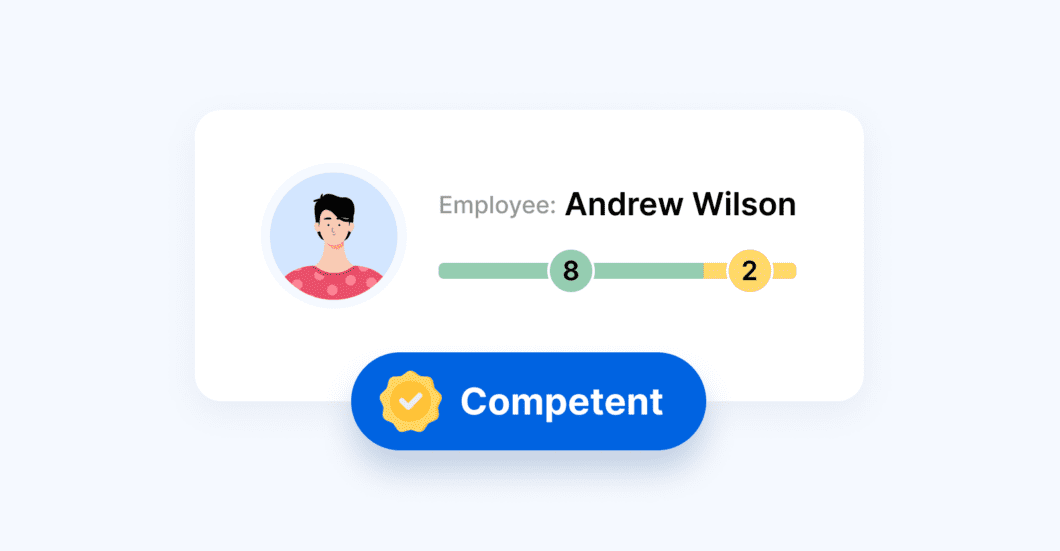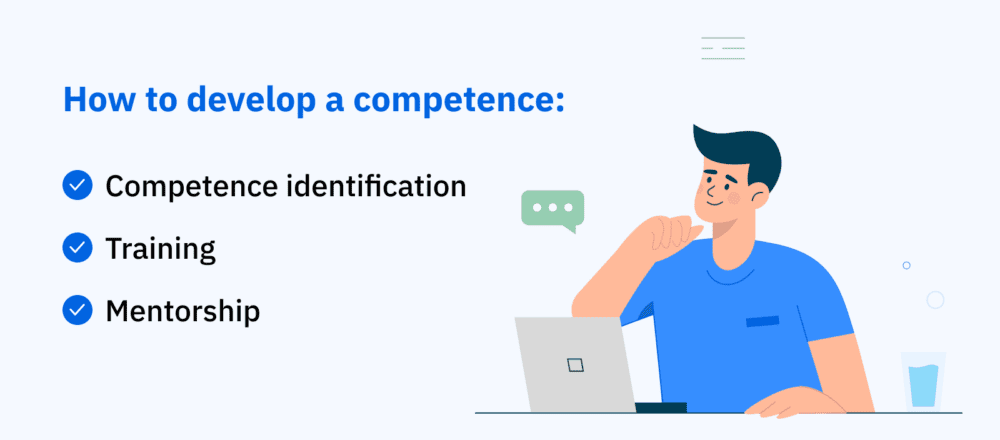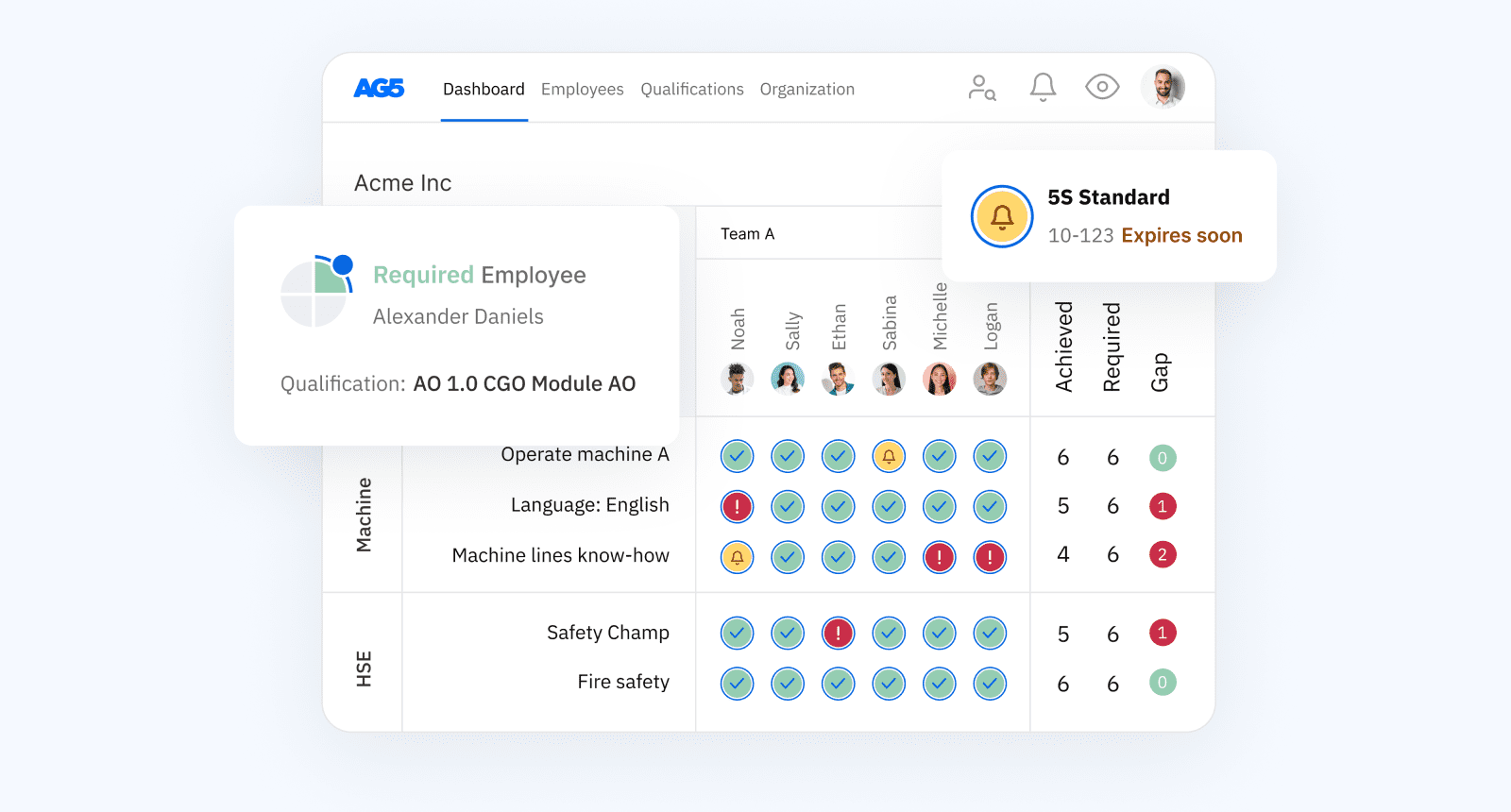What is competence? Explanations and examples
What is competence and how can you develop them? In this article we take a closer look at the definition of competence and a few examples.

An employee’s competence differs from their skill level – and it might even be more valuable. In this article, we’ll take a look at the definition of competence, along with examples, its importance, and look at how AG5’s skills management software can help you develop it.
What is competence? Copied
Competence [1] refers to the ability to do something effectively and efficiently. It encompasses the following three elements:
- Knowledge. Information and experience related to a role or industry
- Skills. An individual’s ability to perform a specific task or solve a problem at a high level of proficiency [2]
- Aptitudes and character traits. The qualities and abilities used to describe and define an individual
This means that competence is broader than skills, even though the two terms are often used interchangeably.
Note: A skill can also be broken down into three elements – and categorized into different types. You’ll need to fully understand both skills and competence to fully leverage your employees’ abilities.
Types and examplesCopied
Let’s take a look at a few examples of various types of competence [3]. For the sake of relevance, we’ll look at competence through an industrial lens.
- Technical competence. A machinist skilled in operating CNC machines
- Safety competence. A factory supervisor with expertise in implementing and enforcing safety protocols
- Process competence. A chemical engineer knowledgeable in optimizing production processes
- Quality competence. An inspector trained in ensuring products meet industry standards before shipment
- Supply chain competence. A logistics manager proficient in coordinating timely deliveries of raw materials
- Maintenance competence. An industrial mechanic experienced in troubleshooting and repairing machinery
While the above examples are very specific, competence can also be very broad. Examples here include the following:
- Adaptability. The ability to act effectively even in the face of changing working conditions, tasks, and responsibilities
- Communication. The ability to effectively express oneself, both verbally and in writing, to formulate ideas clearly and concisely, and to communicate and present these to others
- Learning. An individual with a knack for quickly grasping new concepts and adapting to different learning environments
- Leadership. A person with the ability to inspire and guide others toward achieving common goals
- Time management. Someone skilled in prioritizing tasks, organizing schedules, and meeting deadlines efficiently
What it means to develop a competenceCopied
Developing a competence means working to improving skills and knowledge related to a certain area so you can improve how well and how efficiently you can perform your work [4]
To do so, you’ll need to focus on the following areas:
- Knowledge acquisition. Understanding the theories, principles, concepts, and facts related to a particular subject or field. This includes formal education, courses, self-studying, and reading
- Skill development. Developing competence requires improving skills through practice, repetition, and hands-on experience.
- On-the-job experience. Competence is often built through real-world experience. This means actively applying knowledge and skills in work situations.
- Continuous learning. Competence requires a commitment to ongoing learning and development. This involves staying updated with the latest trends, technologies, and best practices, whether they’re for your role, industry, or field.
Why acquiring and mastering a competence is so importantCopied
Because competencies are broader than skills, they can be applied to larger areas – and are therefore more future-proof. [5]
For example, certain tools, equipment, or machinery will eventually become obsolete as new technology emerges. However, employees who have developed the competence to learn how to use new machines will be able to adapt, ensuring that they can keep up with market shifts or technological advancements.
While skills are undeniably important, they also have the potential to be more useful in the short term. Competencies, on the other hand, are adaptable, making them extremely valuable in achieving long-term goals.
How to develop a competenceCopied
To develop a competence – or the competencies of your employees – you’ll need to take a multipronged approach that focuses on:
- Competence identification. Determine the skills, knowledge, and abilities you need to achieve your goals
- Training. Take formal courses, attend workshops, seminars, or enroll in online classes related to your field of interest
- Mentorship. Work with and ask for feedback from mentors, peers, or supervisors. Constructive feedback helps you identify areas for improvement
Here, the onus is also on business leaders to cultivate an environment in which employees can develop their innate competencies, as well as those that interest them. This will require a comprehensive, well-honed strategy that allows you to track and manage the competencies that your employees have, need, and want.

Skills matrices are an example of useful tools for mapping your staff’s skills and competencies. You can download our free Excel skills matrix template to help get you started, or look at our database of pre-populated, industry-specific skills matrices.
Alternatively, you can read our guide to creating an Excel-based skills matrix to make your own.
Develop competence with AG5’s skills matrix softwareCopied
Once you’ve laid a foundation for competence development in your organization, you may want to shift to AG5’s skills management software, as working with Excel-based skills matrices in the long-term can be complex and cumbersome.
With AG5, you can:
- Quickly and easily see the competencies your employees possess – and those they need
- Develop targeted training plans to fill competence gaps that may lead to operational inefficiency
- Tailor and customize skills matrices to specific teams, departments, locations, or managers
- Easily find replacements for staff out sick, or successors for employees leaving the organization
Ready to see how this could work in an organization? Request a free, live, 15-minute demo for a customized look at AG5 in action.

Sources Copied
- Change view: Table
-
APA
| # | Source title | Description | Publication | Retrieved | Source URL |
|---|---|---|---|---|---|
| 1 | What is Competence. | IGI Global | - | April 22, 2024 | https://www.igi-global.com/dic.. |
| 2 | Types Of Competencies (And How They Differ From Skills). | Indeed | - | April 22, 2024 | https://in.indeed.com/career-a.. |
| 3 | 55 Competence Examples. | Helpful Professor | - | April 22, 2024 | https://helpfulprofessor.com/c.. |
| 4 | 4. Developing competence: definition, types and how-to guide | Indeed | - | April 22, 2024 | https://uk.indeed.com/career-a.. |
| 5 | Skills change, but capabilities endure. | Deloitte | - | April 22, 2024 | https://www2.deloitte.com/uk/e.. |
Author Copied
Revisions Copied
Update Reason: Added sections, refreshed content, added sources
Written by: Rick van Echtelt
Technically reviewed by: Adam Kohut

